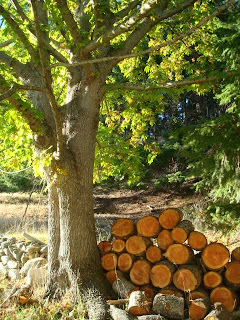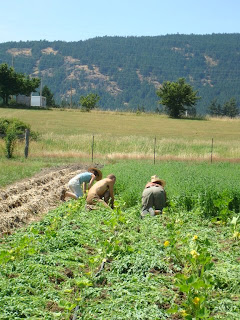
After the coast I headed inland to meet up with my friend Josafat. We went north of Mexico City to Pachuca where his girlfriend was having her big birthday fiesta at her parents' house. There was alcoholic horchata, artisenal mezcal, a keg of beer, chicken chalupas, jicama chile salad, fresh strawberries and cream, hoards of old friends... and a karoake machine! Party guests sang for hours and hours, from Mexican pop music to American rock to traditional norteño. I personally rocked some Shakira, Juanes, Beatles, and Nirvana.

In the morning the party continued and 2 carloads of us drove up into the hills to the small, quaint village of Real del Monte. It is actually considered one of the 12 "magical villages" of Mexico, along with Real de Catorce, San Miguel de Allende, Tepoztlan, Cuetzalan, and I don't know where else. But it definitely has an colonial, frozen-in-time feel, the way that inland Mexico is often depicted in movies. Right by there is El Chico National Park, the first preservation land in all of Latin America. There are cedars and pines along with bromeliads hanging from the trees.
Once the weekend of fun was over, it was time to get to work. Josa and I took an overnight bus south to Tlapa de Comonfort, Guerrero, the small city where his office is based out of. The city was recently militarized due to drug-trafficking, and uniformed men with huge guns abound, which kind of freaked me out of at first. But now I go jogging in the mornings and run past them without thinking about it too much.
Josafat works for a government-funded food security program called PESA (Proyecto Estrategico de Seguridad Alimentaria). With 17 development engineers, they work in about 65 indigenous communities throughout the state. He is one of the coordinators of these engineers, and oversees their projects.
There are 3 different ethnic groups in this region (Nahua, Mixteco, and Tlapaneco) and their villages are anywhere from a half hour to a 6 hour drive from Tlapa de Comonfort. Within the scope of their program, they are only reaching about 10% of the indigenous population in the state, which is one of the poorest in the country.

The PESA employees do educational workshops in the villages, and then do a participatory demonstration project with a resident so others can learn how it's done. Then an engineer is there to help anyone else do their own project. This year they have focused on building wood-efficient cookstoves (as opposed to cooking over an open fire), chicken/turkey coops, composting-toilet bathrooms, ferrocement water storage tanks, and home gardens.

On an average day, we leave town at 7am and drive a couple hours with the 5 other members of Josafat's team in the cab of his pickup. It's cramped, but these are all jolly co-workers, a couple of whom speak Nahautl or Mixteco. These are hot, dusty, windy mountain roads. It is about a month until the rainy season begins, so right now is the driest part of the year. We finally get to one of the communities, and the town announces our arrival over a loudspeaker so that everyone knows it's time for a meeting.
Señoras slowly start making their way toward the meeting hall, most carrying a baby on back or with small kids trailing behind. In all 3 local languages,
nana means señora or ma'am. This is a Mixteco village, so we shake all their hands and greet them with a hello,
Kwa u nana! It is only women who are involved in the project; since they do all the cooking, they have the most relation with the question of food security. Plus, men and women's work does not frequently mix here, so it is all women and children, maybe 70 in all, who arrive for the meeting. As the program is winding down for the year, now is the time for closing workshops, to evaluate what worked and what could be improved.

As these communities, and individual people, are receiving government money, the program has to maintain good paperwork to prove that the money is being used for its right purpose. So every person who has received money has to sign their name on a form, and this takes the first hour. As a lot of them cannot write, they put their fingerprint. They break into groups to discuss the various projects that they have done, as well as to talk about the upcoming environmental conservation efforts that will start next.
I help Josafat do some very basic environmental education, talking about the effects of mass deforestation on the hillsides, erosion, use of chemical fertilizers in their fields, and the bio-accumulation of contaminants. It's hard to tell how much is being understood without a Mixteco interpretor, as a lot of the community members speak limited Spanish. Josafat says they understand more than they speak, because indeed they are shy of outsiders. More than once a child saw us and burst into tears, reacting to the unfamiliarity of Josafat being a fairly light-skinned Meztizo and to me being a
guerra.
One great thing about the program is that they only do projects with people who want them, and they provide materials and technical help, but the community has to do most of the work themselves. That way, they learn new skills and are invested in the results. Much of the Mexican government's assistance to the poorest population have been in the form of handouts, just giving money or materials without any follow-through on how it is used. In almost every community I saw piles of unused building materials, such as wood shingles or rebar or bags of cement or wheelbarrows- provided on some other occasion without a community liason, education, training, or follow-up.
The majority of men who would know what to do with these materials are outside the community, either migrated to work in northern Mexico or the U.S. PESA is non-partisan and seeks to create more long-term solutions for healthy, self-sufficient, and sustainable food systems.

The community members always offer to feed these rural technicians who have traveled a long way. One day it was chicken in a red mole, with hot tortillas off the comal as the señora made them. No utensils, just tortillas as an eating medium. Oh, and a big soda. As Josafat says, there are many villages without a doctor, but you won't find anywhere without Coca-Cola.
In another community they roasted a sheep as a thankyou for the end of the season. It was a generous, though somewhat gristly meal, served along with green salsa, blue corn tortillas, and the sheep's liver, which I politely declined.
We are almost home around 8pm, and it's been a long 13 hour day. I want nothing more than to take a shower, drink some water, and go to sleep. But no, in one of the closer villages to Tlapa, another place the program works, we stop for beers. I try to refuse, and everyone is puzzled- why would you turn down drinking a cold beer with friends?
"Just don't say that the people of Guerrero didn't try to show you a good time," Josafat's coworkers tell me. Finally after a few rounds, and me translating some Alan Jackson song lyrics for them, we get back to the office in Tlapa... where someone suggests more beer! You have got to be kidding. We are meeting back at the office at 6:45 a.m., and I have a feeling that I'm going to get a little behind on my running schedule this week.

















.JPG)








































